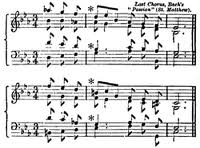Why does music move us? part 5
woensdag, 07 maart 2012 21:28Pitch
As regards pitch, we notice immediately that there is an enormous diversity in pitch of sounds, from very low sounds to very high. We know also that man’s ear is limited in its capacity to detect the pitch of sounds, that there are animals which are capable of hearing sounds at a pitch that man cannot hear. It would be interesting to explore how far animals’ sensing of dangers in the physical world that are movements, such as earthquakes and tidal waves etc., is by hearing. We observe a correspondence between the pitch of a sound and the location of its origin in the physical world: deep, low sounds we can associate with the ‘below’ of the earth, higher sounds with the ‘above’ of the sky. (Perhaps the phenomenon of thunder is so alarming precisely because it is a deep, low sound coming from up above us.)
The pitch of a sound being due to the frequency of the vibrations set in motion by a body resonating due to a movement against it, we notice that there are vibrations that we ‘feel’ throughout our whole body as well as hear, or indeed sometimes that we feel rather than hear. There is a certain touch involved here. This is the case particularly for low sounds. (Animals’ advantage over man for the detection of movements in the physical world perhaps lies in this sensing of movement that is closer to touch, although we should not forget that man is the animal with the most refined sense of touch.) Thanks to the intermediary of the air, a certain contact, therefore, is established between the matter that resonates when struck, and the matter of my body, with the ear being the organ of the body especially designated for the reception of sound, an organ extremely refined for that purpose, even though, as we have noted, it is limited in the range of pitches it can detect.
The pitch of a sound, then, is fundamentally to do with the matter of a body that resonates, and on the receiving end, with the matter of my own body. If we were to look more closely at how matter is linked to pitch, we would perhaps see that it is to do with the density of that matter – more dense matter resonating at a low pitch, more rarefied matter resonating at a high pitch. (Here again we come across the deep sounds of the earth and the high sounds of the air.) If pitch is to do with matter, it is also to do with quantity: larger bodies make lower sounds; smaller bodies make higher sounds. It is, very basically, the length of a string that determines the pitch of its sound when plucked, (the aspect of tension comes second, and is perhaps more to do with density?); the amount of water in a bottle – or rather the amount of air left in the bottle – that determines the pitch of the sound produced by air being blown across the top.
Why does music move us? part 4
maandag, 27 februari 2012 11:12

Sound
Types of sound
We shall begin by considering the different types of sound that exist. There is a basic experience we have of the sounds of the natural, physical world; the sounds of wind, of rain, of an earthquake, of an avalanche, of fire etc. We have seen that sound is caused by movement. The physical world is in constant movement, is constantly changing, constantly being reordered, and the movement proper to the physical world is one of corruption and decomposition: the physical world is fundamentally in corruption. The sounds of the physical world, therefore, are sounds which denote degeneration, the breaking up of an order. They are the sounds of a constant reorganisation that is one of degeneration. This is not to say that they are not pleasant sounds; we enjoy, for example, listening to the sound of breaking waves. But it cannot be denied that in listening to waves breaking upon the shore, we are listening to the slow but sure wearing down of stones to sand – listening for a few moments to the movements of a degenerative process that lasts millions of years.
It is only with the living world that we meet a movement which is one of regeneration rather than of pure degeneration. It is proper to the living being and what characterises it as living, that it regenerates itself. It has an immanence which allows it to be the source of its own movement. If the physical world ‘is moved’, the living world ‘moves itself’. The living world brings us, therefore, to sounds of growth, rather than decay, of a movement that is vital. We see that all movements of the living world, including local movement, are ultimately for the preservation of the individual by nutrition and of the species by generation. All animal cries and calls are directed to these two ends. The sounds of the living world are sounds of movements which are victorious over the pure degeneration of the physical world.
If man is the summit of the living world we also find a summit in sound at the human level, with voice and language. With the voice man has a unique way of expressing his reaction to a sensible reality. The voice is the special vehicle of man’s spontaneous expression of the passions that a sensible reality arouses in him: we think, for example, of a scream of fright, a burst of laughter, a gasp of surprise, a sigh of relief. But in addition to these spontaneous expressions, the voice is also mastered by man: he is capable of conveying meaning, in sound, using language. It is thanks to his intelligence, to his ability to make universal relations, that man has language, and that he instrumentalizes his capacity to make sounds, placing those sounds in a conventional arrangement to convey meaning and express thought. Thus man’s capacity to make sound, coupled with the sense of hearing, is at the foundation of a spiritual communication. It is thanks to the voice and to language that I can enter into contact with my fellow man, that a spiritual contact can be made with another. This is what makes education possible. This is what enables me to know the friend: without speech, without discussion, without the sharing of thoughts, ideas, of each one’s experience of reality, expressed in language it becomes more difficult to know who someone is, to know his person. Indeed, the ultimate use of voice and language for communication will be in the ‘I love you’ expressed to the friend. With this we find the summit of man’s expressing his intentional relation as regards the fellow spiritual reality that is the person of the friend, expressing the most profound vital operation he experiences, that of loving another person.


 De Broeders van Sint Jan hebben hun leven aan God gewijd, ten dienste van God en hun naasten. Zij willen leven volgens het Evangelie van Jezus Christus en zich door hun gebed en hun activiteiten inzetten voor jong en oud.
De Broeders van Sint Jan hebben hun leven aan God gewijd, ten dienste van God en hun naasten. Zij willen leven volgens het Evangelie van Jezus Christus en zich door hun gebed en hun activiteiten inzetten voor jong en oud.